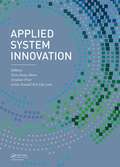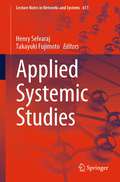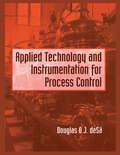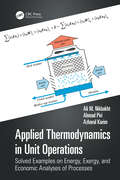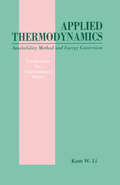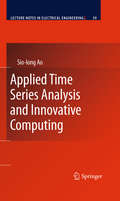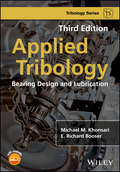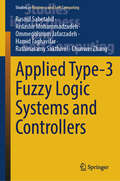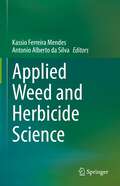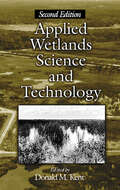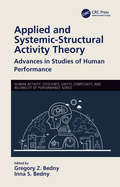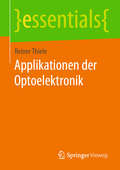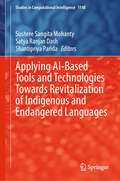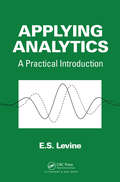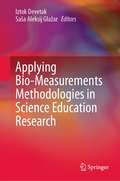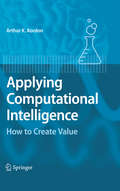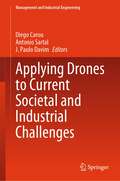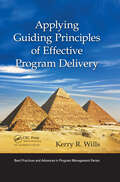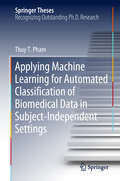- Table View
- List View
Applied System Innovation: Proceedings of the 2015 International Conference on Applied System Innovation (ICASI 2015), May 22-27, 2015, Osaka, Japan
by Teen-Hang Meen Stephen Prior Artde Donald LamThe 2015 International Conference on Applied System Innovation (ICASI 2015) was held May 22-27, 2015 in Osaka, Japan and provided a unified communication platform for researchers active in a wide range of research fields. Professionals from industry, academia and government were encouraged to discourse on research and development, professional practice, business and management in the information, innovation, communication and engineering fields. This conference enabled interdisciplinary collaboration between science and engineering technologists in the academic and industry fields as well as networking internationally. The conference received 1063 submitted papers, whereby 421 papers were selected by the committees to be presented at the ICASI 2015 conference. These papers were divided into 13 Regular Sessions and 13 Invited Sessions, and presented in several parallel sessions. The ICASI 2015 committees selected 226 excellent papers for publication in this proceedings volume, covering topics ranging from information technology, innovation design, communication science and engineering, industrial design, creative design, applied mathematics, computer science, design theory and cultural and creative research to electrical and electronic engineering, mechanical and automation engineering, green technology and architecture engineering and material science, among others.
Applied Systemic Studies (Lecture Notes in Networks and Systems #611)
by Henry Selvaraj Takayuki FujimotoThis book is a collection of a wide range of research papers that combine both the humanities and sciences in applied informatics. In particular, it is intended for readers interested in the fields of artificial intelligence, data science, virtual reality, and intelligent systems.Technologies and findings in artificial intelligence, data science, virtual reality, and intelligent systems are being used in all academic disciplines today. This book is a compilation of specific and advanced research findings from a wide range of research fields where they are being applied today. The papers included are based on those presented in August 2022 at the International Conference on Systems Engineering (ICSEng-Tokyo), a prestigious academic conference that has been held annually since 1974. The papers have been rigorously reviewed and selected by multiple peer reviewers.
Applied Systems Analysis: Science and Art of Solving Real-Life Problems (Advanced Research in Reliability and System Assurance Engineering)
by F. P. TarasenkoApplied Systems Analysis: Science and Art of Solving Real-Life Problems Subject Guide: Engineering – Industrial and Manufacturing Any activity is aimed at solving certain problems, which means transferring a system from an existing unsatisfactory problematic state to a desired state. The success or failure of the system depends on how its natural properties were implemented during the planning of improvement and intervention state. This book covers the theory and experience of successfully solving problems in a practical and general way. This book includes a general survey of modern systems analysis; offers several original results; presents the latest methodological and technological results of the theory of systems; introduces achievements; and discusses the transition from the ideology of the machine age to the ideology of the systems age. This book will be of interest to both professionals and academicians.
Applied Technology and Instrumentation for Process Control
by Douglas O. de SaApplied Technology and Instrumentation for Process Control presents the complex technologies of different manufacturing processes and the control instrumentation used. The large variety of processes prohibits covering more than a few. Carefully selected and diverse, but representative, examples show how fundamentally basic simpler elements or techn
Applied Thermodynamics in Unit Operations: Solved Examples on Energy, Exergy, and Economic Analyses of Processes
by Azharul Karim Ali M. Nikbakht Ahmad PiriThe growing demand of energy accounting in industries is the main challenge for academics and engineers working in chemical processing plants, food industries, and the energy sector. Applied Thermodynamics in Unit Operations addresses this demand and offers a clear contribution to the quantification of energy consumption in processes, while also solving the economic aspects of energy that are vital in real-life industrial contexts. Features• Combines the energy and exergy routines to analyze utilities and unit operations in a wide range of engineering scopes: nozzles, turbines, compressors, evaporators, HVAC, drying technology, steam handling, and power generation. • Offers a detailed procedure of finding economic wealth of energy in the operations. • Discusses basic concepts of thermal engineering and industrial operational insights through practiced examples, schematic illustrations, and software codes. • The only book to include practical problems of industrial operations solved in detail and complementary EES codes for the solutions. • Features examples selected from authors’ real-world experience in industrial projects. The book is a handy reference for researchers and practitioners in the areas of process, chemical, and mechanical engineering, undergraduate and postgraduate students in those disciplines, and engineers working in industry and production managers. Some examples are solved in EES to help the audience apply computer coding for thermal calculations.
Applied Thermodynamics: Availability Method And Energy Conversion (Combustion: An International Series #5)
by KamW. LiDeals with the availability method and its application to power plant system design and energy conversion. The first part of the book describes the development and the formulation of the availability method. The second part presents its applications to energy conversion processes. Examples for each energy conversion system are introduced and there are practice problems throughout the text.
Applied Time Series Analysis and Innovative Computing (Lecture Notes In Electrical Engineering #59)
by Sio-Iong AoApplied Time Series Analysis and Innovative Computing contains the applied time series analysis and innovative computing paradigms, with frontier application studies for the time series problems based on the recent works at the Oxford University Computing Laboratory, University of Oxford, the University of Hong Kong, and the Chinese University of Hong Kong. The monograph was drafted when the author was a post-doctoral fellow in Harvard School of Engineering and Applied Sciences, Harvard University. It provides a systematic introduction to the use of innovative computing paradigms as an investigative tool for applications in time series analysis. Applied Time Series Analysis and Innovative Computing offers the state of art of tremendous advances in applied time series analysis and innovative computing paradigms and also serves as an excellent reference work for researchers and graduate students working on applied time series analysis and innovative computing paradigms.
Applied Tribology: Bearing Design and Lubrication
by E. Richard Booser Michael M. KhonsariApplications of tribological technology in bearings are wide and varied in industries ranging from aerospace, marine and automotive to power, process, petrochemical and construction. Applied Tribology, 2nd edition not only covers tribology in bearings but demonstrates the same principles for other machine components, such as piston pins, piston rings and hydrostatic lifts, as well as in more recent technologies such as gas bearings in high-speed machines and computer read-write devices. Maintaining a balance between theoretical analysis and practical experience with co-authors from academia and industry, this new edition is significantly revised and expanded with new material. Features include; - Two brand new chapters on seals and bearing failure modes and bearing health monitoring techniques- Coverage of new developments in full-film, dry, and partial lubrication; gas bearings; and ball and roller bearings- Design guides based on full Reynolds equation that enable accurate prediction of load capacity, power loss, temperature rise- Comprehensive presentation of important design factors involving material and lubricants. - State-of-the-art presentation and up-to-date references of pertinent scientific and applied topics in tribology- Numerous examples that reinforce the understanding of concepts and provide procedures for the design and performance analysis of components Applied Tribology, 2nd edition provides a valuable and authoritative resource for mechanical engineering professionals working in a wide range of industries with machinery including turbines, compressors, motors, electrical appliances & electronic components. Senior and graduate students in mechanical engineering will also find it a useful text and reference.
Applied Type-3 Fuzzy Logic Systems and Controllers (Studies in Fuzziness and Soft Computing #417)
by Hamid Taghavifar Chunwei Zhang Rathinasamy Sakthivel Ardashir Mohammadzadeh Rasoul Sabetahd Ommegolsoum JafarzadehThis book provides the fundamental approaches to designing and using type-3 fuzzy systems in real-world applications. Basic Matlab codes are provided to use type-3 fuzzy systems in a straightforward scheme. The main differences between type-3 fuzzy systems and other types are analyzed and compared. The effectiveness of type-3 fuzzy systems is analyzed and studied in various applications, such as robotics, intelligent control systems, and data science.
Applied Water Science, Volume 2: Remediation Technologies
by Inamuddin Mohd Imran Ahamed Tauseef Ahmad Rangreez Rajender BoddulaThe high rate of industrialization around the world has led to an increase in the rate of anthropogenic activities which involves the release of different types of contaminants into the aquatic environment generating high environmental risks, which could affect health and socio-economic activities if not treated properly. There is no doubt that the rapid progress in improving the water quality and management has been motivated by the latest developments in green chemistry. Over the past decade, sources of water pollutants and the conventional methods used for the treatment of industrial wastewater treatment has flourished. Water quality and its adequate availability have been a matter of concern worldwide particularly in developing countries. According to a World Health Organization (WHO) report, more than 80% of diseases are owing to the consumption of contaminated water. Heavy metals are highly toxic that are a potential threat for water, soil, and air, their consumption in higher concentrations provided hazardous outcomes. The water quality is usually measured keeping in mind chemical, physical, biological, and radiological standards. The discharge of the effluent by industries contains heavy metals, hazardous chemicals, and a high amount of organic and inorganic impurities those can contaminate the water environment, and hence, human health. Therefore, it is our primary responsibility to maintain the water quality in our respective countries. This book provides understanding, occurrence, identification, toxic effects and control of water pollutants in aquatic environment using green chemistry protocols. It focuses on water remediation properties and processes including industry-scale water remediation technologies. This book covers recent literature on remediation technologies in preventing water contamination and its treatment. Chapters in this book discuss remediation of emerging pollutants using nanomaterials, polymers, advanced oxidation processes, membranes, and microalgae bioremediation, etc. It also includes photochemical, electrochemical, piezoacoustic, and ultrasound techniques. It is a unique reference guide for graduate students, faculties, researchers and industrialists working in the area of water science, environmental science, analytical chemistry, and chemical engineering.
Applied Water Science: Fundamentals and Applications
by Inamuddin Mohd Imran Ahamed Tauseef Ahmad Rangreez Rajender BoddulaWater is one of the most precious and basic needs of life for all living beings, and a precious national asset. Without it, the existence of life cannot be imagined. Availability of pure water is decreasing day by day, and water scarcity has become a major problem that is faced by our society for the past few years. Hence, it is essential to find and disseminate the key solutions for water quality and scarcity issues. The inaccessibility and poor water quality continue to pose a major threat to human health worldwide. Around billions of people lacking to access drinkable water. The water contains the pathogenic impurities; which are responsible for water-borne diseases. The concept of water quality mainly depends on the chemical, physical, biological, and radiological measurement standards to evaluate the water quality and determine the concentration of all components, then compare the results of this concentration with the purpose for which this water is used. Therefore, awareness and a firm grounding in water science are the primary needs of readers, professionals, and researchers working in this research area. This book explores the basic concepts and applications of water science. It provides an in-depth look at water pollutants’ classification, water recycling, qualitative and quantitative analysis, and efficient wastewater treatment methodologies. It also provides occurrence, human health risk assessment, strategies for removal of radionuclides and pharmaceuticals in aquatic systems. The book chapters are written by leading researchers throughout the world. This book is an invaluable guide to students, professors, scientists and R&D industrial specialists working in the field of environmental science, geoscience, water science, physics and chemistry.
Applied Weed and Herbicide Science
by Kassio Ferreira Mendes Antonio Alberto da SilvaThis textbook explores aspects of biology and ecophysiology of weeds, weed competition and interference in crops, phytosociological survey, methods of control and weed integrated management. Herbicides are of great importance in weed management and are one of the most widely used pesticide groups for weed control across the globe. Offering a new direction for research that focuses on herbicide behavior in plants, hormesis, evolution of weed resistance to herbicides, and genetically modified crops resistant to herbicides, this book covers the recent research in applied weed and herbicide science.This book provides essential and updated information on various subjects regarding the advances in herbicide science; and it is intended for professors, undergraduate, and graduate students, rural producers and other professionals involved in the area of applied weed and herbicide science. Agriculturists, analytical chemists, and toxicologists will find this book rewarding.
Applied Wetlands Science and Technology
by Donald M. KentContinuing the tradition of excellence established by the first edition, the Second Edition of Applied Wetlands Science and Technology provides the fundamentals for delineating, identifying, and regulating wetlands. It covers functions and values, ecological assessments, and how to minimize negative impacts on wetlands. The book also presents essen
Applied and Systemic-Structural Activity Theory: Advances in Studies of Human Performance (Human Activity)
by Gregory Z. Bedny Inna S. BednyThis book presents new data in Applied Activity Theory (AAT) and Systemic-Structural Activity Theory (SSAT), that can be used in the study of human performance. The SSAT is the high-level generality theory that offers standardized principles of the analyses of human activity. These principles can be utilized in theoretical and applied studies. This multi-contributed book offers a selection of works that will provide a holistic picture of the field. The new data can be utilized for the study of extremely complex human-machine and human-computer interaction systems, and for evaluation of efficiency, complexity, and reliability of such systems at the design stage. Features Shows examples of self-regulative models of various cognitive processes Illustrates a method of study of production process in the construction industry Includes topics on learning, training, and management Covers a new method of computer based automated support of decision making under risk and uncertainty Presents a new method of evaluation of probabilistic structure of tasks, and the method of assessing reliability of human performance
Applikationen der Optoelektronik (essentials)
by Reiner ThieleIn der hochbitratigen optischen Nachrichtentechnik ist es wichtig, parasitäre induktive und kapazitive Einflüsse auf die Funktion von Laser- und Fotodioden zu kompensieren. Wegen des nichtlinearen Charakters der u-i-Relationen der Induktivitäten, Kapazitäten und Widerstände ist es möglich, Kompensationsverfahren gegen parasitäre Effekte zu entwickeln oder die Nichtlinearitäten gezielt zur Signalübertragung einzusetzen. Reiner Thiele beweist, dass bei Applikation der vorgestellten Kompensationsverfahren kapazitive und induktive Influenzen auf die Grundfunktion der optoelektronischen Bauelemente vermeidbar sind, das Klemmenverhalten durch die u-i-Kennlinien von Laser- oder Fotodioden komplett erfasst wird und ungünstige Einflüsse der Systemumgebung auf die optoelektronischen Schaltungen vermieden werden. Außerdem stellt er Definitionen für optoelektronische Grundstromkreise sowie ihre Berechnung für die Applikation gleichartiger Laser- oder Fotodioden als Sende- bzw. Empfangsbauelemente der optischen Nachrichtentechnik vor.Der Autor: Prof. Dr.-Ing. Reiner Thiele lehrte an der Hochschule Zittau/Görlitz und unterrichtet derzeit an der Staatlichen Studienakademie Bautzen.
Applying AI-Based Tools and Technologies Towards Revitalization of Indigenous and Endangered Languages (Studies in Computational Intelligence #1148)
by Satya Ranjan Dash Shantipriya Parida Sushree Sangita MohantyThis book emphasises the need for language resource development and its impact on society. It covers latest AI based tools and techniques used to preserve indigenous and endangered languages. The book also highlights latest AI based technologies such as Generative Pre-trained Transformer (GPT) towards endangered language preservation. It discusses morphology analysis, translation support and shallow parsing of various tribal languages of India and abroad. This book tries to answer how digital technologies can make language revitalization accessible to future generations.
Applying Analytics: A Practical Introduction
by E. S. LevineNewcomers to quantitative analysis need practical guidance on how to analyze data in the real world yet most introductory books focus on lengthy derivations and justifications instead of practical techniques. Covering the technical and professional skills needed by analysts in the academic, private, and public sectors, Applying Analytics: A Practic
Applying Bio-Measurements Methodologies in Science Education Research
by Iztok Devetak Saša Aleksij GlažarThis book illustrates the problems of using eye tracking technology and other bio-measurements in science education research. It examines the application of bio-measurements in researching cognitive processes, motivation for learning science concepts, and solving science problems. Most chapters of this book use the eye-tracking method, which enables following the focus of the students’ attention and drawing conclusions about the strategies they used to solve the problem. This book consists of a total of fifteen chapters. Authors from eight countries emphasise the same trends despite their cultural and educational differences. The book begins with general chapters describing cognitive processes and how these processes are measured using eye-tracking methods and other psychophysiology parameters and motivation. Finally, the book concludes the chapters presenting studies in specific scientific fields from chemistry, biology, physics and geology.
Applying Computational Intelligence: How to Create Value
by Arthur KordonThe flow of academic ideas in the area of computational intelligence is impacting industrial practice at considerable speed. Practitioners face the challenge of tracking, understanding and applying the latest techniques, which often prove their value even before the underlying theories are fully understood. This book offers realistic guidelines on creating value from the application of computational intelligence methods. In Part I, the author offers simple explanations of the key computational intelligence technologies: fuzzy logic, neural networks, support vector machines, evolutionary computation, swarm intelligence, and intelligent agents. In Part II, he defines the typical business environment and analyzes the competitive advantages these techniques offer. In Part III, he introduces a methodology for effective real-world application of computational intelligence while minimizing development cost, and he outlines the critical, underestimated technology marketing efforts required. The methodology can improve the existing capabilities of Six Sigma, one of the most popular work processes in industry. Finally, in Part IV the author looks to technologies still in the research domain, such as perception-based computing, artificial immune systems, and systems with evolved structure, and he examines the future for computational intelligence applications while taking into account projected industrial needs. The author adopts a light tone in the book, visualizes many of the techniques and ideas, and supports the text with notes from successful implementations. The book is ideal for engineers implementing these techniques in the real world, managers charged with creating value and reducing costs in the related industries, and scientists in computational intelligence looking towards the application of their research.
Applying Data Science: How to Create Value with Artificial Intelligence
by Arthur K. KordonThis book offers practical guidelines on creating value from the application of data science based on selected artificial intelligence methods. In Part I, the author introduces a problem-driven approach to implementing AI-based data science and offers practical explanations of key technologies: machine learning, deep learning, decision trees and random forests, evolutionary computation, swarm intelligence, and intelligent agents. In Part II, he describes the main steps in creating AI-based data science solutions for business problems, including problem knowledge acquisition, data preparation, data analysis, model development, and model deployment lifecycle. Finally, in Part III the author illustrates the power of AI-based data science with successful applications in manufacturing and business. He also shows how to introduce this technology in a business setting and guides the reader on how to build the appropriate infrastructure and develop the required skillsets. The book is ideal for data scientists who will implement the proposed methodology and techniques in their projects. It is also intended to help business leaders and entrepreneurs who want to create competitive advantage by using AI-based data science, as well as academics and students looking for an industrial view of this discipline.
Applying Drones to Current Societal and Industrial Challenges (Management and Industrial Engineering)
by J. Paulo Davim Diego Carou Antonio SartalThis book explores drone applications and the cutting-edge technologies that drive their functionality. From transforming everyday challenges like traffic congestion to enhancing efficiency in fields such as search and rescue operations, protection of critical infrastructure, and medicine, the book explores how drones serve as powerful allies to address diverse human needs. The chapters not only showcase the applications of drone technology but also shed light on how these vehicles can revolutionize commonplace tasks, such as delivering packages with unprecedented efficiency. The book also explores technological intricacies, regulatory considerations, and the evolving demands of today's consumers. By providing a holistic view, it equips readers with a deep understanding of the multifaceted landscape surrounding drone technology.
Applying Ecosystem and Landscape Models in Natural Resource Management
by Robert E. KeaneManaging today’s lands is becoming an increasingly difficult task. Complex ecological interactions across multiple spatiotemporal scales create diverse landscape responses to management actions that are often novel, counter-intuitive and unexpected. To make matters worse, exotic invasions, human land use, and global climate change complicate this complexity and make past observational ecological studies limited in application to the future. Natural resource professionals can no longer rely on empirical data to analyze alternative actions in a world that is rapidly changing with few historical analogs. New tools are needed to synthesize the high complexity in ecosystem dynamics into useful applications for land management. Some of the best new tools available for this task are ecological and landscape simulation models. However, many land management professionals and scientists have little expertise in simulation modeling, and the costs of training these people will probably be exorbitantly high because most ecosystem and landscape models are exceptionally complicated and difficult to understand and use for local applications. This book was written to provide natural resource professionals with the rudimentary knowledge needed to properly use ecological models and then to interpret their results. It is based on the lessons learned from a career spent modeling ecological systems. It is intended as a reference for novice modelers to learn how to correctly employ ecosystem landscape models in natural resource management applications and to understand subsequent modeling results.
Applying Guiding Principles of Effective Program Delivery
by Kerry R. WillsWhile today's programs continue to grow in size and complexity, their success rates remain low. To manage programs effectively in this environment, project managers and program managers must take a consultative approach that applies a core set of guiding principles across every function of the program. This book explains what it means to take a consultative approach. Instead of focusing on specific program management techniques, it covers the guiding principles required to make those techniques effective-making it applicable to any program in any industry.
Applying Lean Six Sigma in the Pharmaceutical Industry
by Bikash ChatterjeeBikash Chatterjee emphasizes the criticality of applying the principles of Lean and Six Sigma within the paradigm of the drug development process. His guide to operational excellence in the pharmaceutical and biotech industries is a focused summary of the application of Lean Six Sigma theory to the regulated life sciences. From molecule discovery to the application of PAT Applying Lean Six Sigma in the Pharmaceutical Industry will highlight the importance of framing these initiatives within the key deliverables of drug development manufacturing and quality. Challenging conventional wisdom the author offers a quality and efficiency perspective as a foundation for the principles of Quality by Design, PAT and the new philosophies underlying Process Validation. Each chapter includes discussion around the considerations for applying Lean manufacturing and Six Sigma principles and their tools, culminating in a case study to illustrate the application. The book is organized to reflect the major work centers involved in the drug development lifecycle. Each chapter is stand-alone but together they illustrate the necessary synergy between Lean, Six Sigma and compliance sensibilities required to be successful in the pharmaceutical industry. These design, manufacturing and management techniques are not without their challenges. Bikash Chatterjee's book offers the roadmap for an industry that is struggling to reinvent many of its development and business processes.
Applying Machine Learning for Automated Classification of Biomedical Data in Subject-Independent Settings (Springer Theses)
by Thuy T. PhamThis book describes efforts to improve subject-independent automated classification techniques using a better feature extraction method and a more efficient model of classification. It evaluates three popular saliency criteria for feature selection, showing that they share common limitations, including time-consuming and subjective manual de-facto standard practice, and that existing automated efforts have been predominantly used for subject dependent setting. It then proposes a novel approach for anomaly detection, demonstrating its effectiveness and accuracy for automated classification of biomedical data, and arguing its applicability to a wider range of unsupervised machine learning applications in subject-independent settings.
